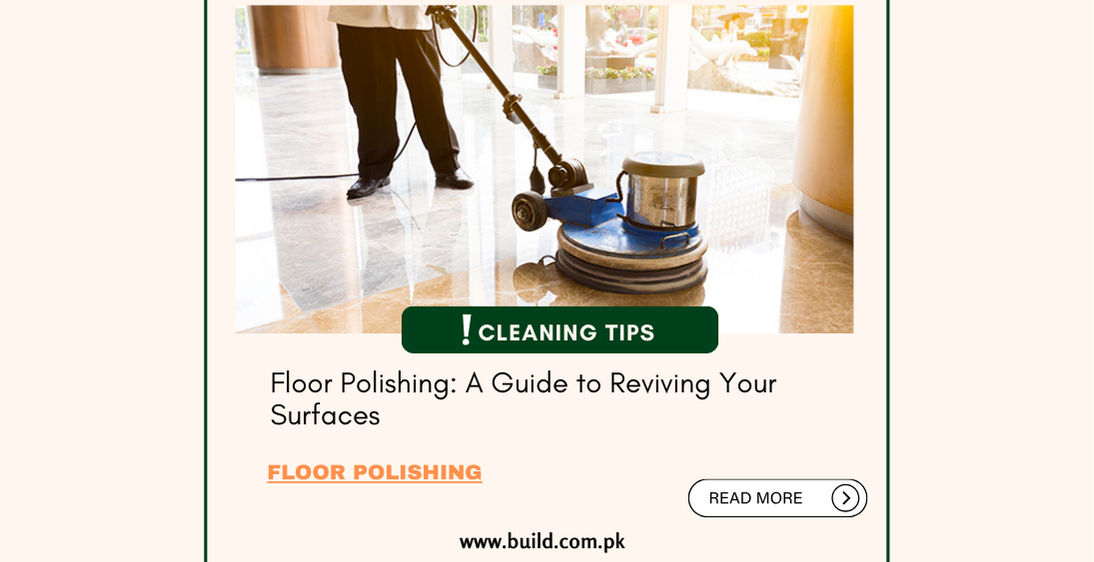Floor Polishing: A Guide to Reviving Your Surfaces

Introduction:
Floor polishing stands as a transformative process, breathing
new life into tired surfaces and elevating the overall aesthetic appeal of any
space. From hardwood floors to marble and concrete, the art of floor polishing
rejuvenates surfaces, leaving behind a lustrous shine and a durable finish. In
this detailed blog, we embark on a journey to explore the intricacies of floor
polishing, uncovering its benefits, techniques, types, and ma intenance tips.
Understanding Floor Polishing:
Floor polishing is a multi-step process aimed at restoring
the natural beauty and shine of various flooring materials. Whether your floors
are marred by scratches, dullness, or wear and tear, polishing can effectively
address these issues, leaving behind a smooth, gleaming surface.

Types of Flooring Suitable for Polishing
Hardwood Flooring:
Hardwood floors are a popular choice for
polishing, as they lend themselves well to the proess. Whether it's oak,
maple, or walnut, hardwood floors can be brought back to life with the right
polishing techniques, enhancing their natural grains and colors.
Marble Flooring:
Marble floors exude elegance and
sophistication, but over time, they can lose their luster due to foot traffic
and wear. Polishing marble floors involves honing the surface to remove
imperfections and applying a protective sealant to enhance their shine and
durability.
Concrete Flooring:
Concrete floors, commonly found in
industrial and commercial settings, can also benefit from polishing. Polished
concrete floors are not only aesthetically pleasing but also incredibly durable
and resistant to stains and scratches.
Benefits of Floor Polishing
Enhanced Aesthetic Appeal:
One of the primary benefits of
floor polishing is the improvement in the overall appearance of the floors.
Polished surfaces boast a reflective shine that enhances the ambiance of any
space, making it appear brighter and more inviting.
Increased Durability:
Floor polishing not only enhances the
visual appeal of the floors but also improves their durability. The protective
sealant applied during the polishing process acts as a barrier against
scratches, stains, and other forms of damage, prolonging the lifespan of the
floors.
Ease of Maintenance:
Polished floors are easier to clean and
maintain compared to untreated surfaces. The smooth, non-porous finish prevents
dirt and grime from penetrating the surface, making it effortless to wipe away
spills and debris.
Healthier Indoor Environment:
Polished floors contribute to a
healthier indoor environment by minimizing the accumulation of dust, allergens,
and bacteria. The smooth surface inhibits the growth of microorganisms,
promoting better indoor air quality and reducing the risk of respiratory
issues.
Floor Polishing Techniques
Surface Preparation:
The first step in the floor polishing
process involves thorough surface preparation. This may include cleaning the
floors to remove dirt and debris, repairing any cracks or imperfections, and
ensuring the surface is smooth and level.
Grinding:
For surfaces with deep scratches or stains,
grinding may be necessary to level the surface and remove imperfections. This
involves using coarse abrasive pads or diamond grinding tools to resurface the
floors.
Honing:
Honing is a finer grinding process that smoothens the
surface and removes any remaining scratches or imperfections. This step creates
a uniform surface texture in preparation for the polishing phase.
Polishing:
The final step in the floor polishing process
involves polishing the surface to achieve a gossy shine. This is typically
done using progressively finer abrasive pads or polishing compounds, followed
by the application of a protective sealant.
Floor Polishing Maintenance Tips
Regular Cleaning:
To maintain the shine and durability of
polished floors, it's essential to clean them regularly using a neutral pH
cleaner and a damp mop or cloth. Avoid using harsh chemicals or abrasive
cleaners, as these can damage the surface.
Protective Measures:
Place rugs or mats in high-traffic areas
to minimize wear and tear on polished floors. Use felt pads or furniture glides
under heavy furniture legs to prevent scratching or scuffing of the floors.
Periodic Maintenance:
Depending on the type of flooring
material and the level of foot traffic, polished floors may require periodic
maintenance to restore their shine. This may involve re-polishing or re-sealing
the floors as needed.
Avoiding Excessive Moisture:
While polished floors are
generally water-resistant, excessive moisture can still damage the surface over
time. Wipe up spills promptly and avoid using excessive amounts of water when
cleaning polished floors.
Conclusion:
In conclusion, floor polishing is a transformative process
that rejuvenates surfaces, enhances their aesthetic appeal, and prolongs their
lifespan. Whether it's hardwood, marble, or concrete, polished floors exude
elegance and sophistication, making them a valuable investment for any space.
By understanding the benefits, techniques, and maintenance tips of floor
polishing, homeowners and property owners can enjoy the tmeless beauty and
durability of polished floors for years to come.









